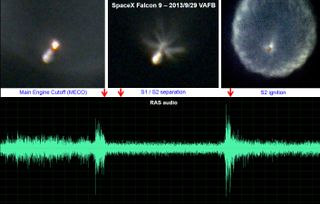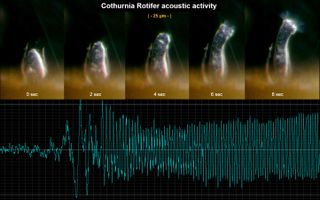
Listening for Alien Life: Could New Tech Detect Microbe Movements?

PASADENA, California — Spacecraft may one day be able to detect alien life by listening to the sounds microbes make.
Scientists are testing a new microphone technology called the remote acoustic sensor (RAS), which is capable of capturing sounds within extreme and often inaccessible aerospace environments. A miniaturized version of the device could theoretically make its way to Mars or to Jupiter's ocean-harboring moon, Europa, to listen for signs of life, researchers said.
"If there's life, and if it moves, it may make RAS-detectable sounds," said RAS lead technologist Dan Slater, an independent consultant based in La Habra Heights, California. Slater presented a review of his work on the RAS concept here Sept. 2 at the American Institute of Aeronautics and Astronautics' (AIAA) Space 2015 meeting. [6 Most Likely Places for Alien Life in the Solar System]
Capturing sounds

The RAS detector assembly is sensitive to small audio-frequency variations in electromagnetic energy, Slater said. The technology becomes even more interesting and useful, he added, when combined with time-synchronized high-resolution imagery of the same scene.
To showcase his idea, Slater has used a ground-based, long-range RAS telescope to obtain visual and audio recordings of a SpaceX Falcon 9 rocket launch that took place in September 2013. He also monitored a test earlier this year of a rocket motor that will be incorporated into NASA's heavy-lift Space Launch System rocket.
RAS technology has also recorded the sound of a plane landing at Los Angeles International Airport, capturing the audio from the summit of Mount Wilson, some 28 miles (45 kilometers) away. A spectrogram produced from the recording shows several descending tones that were produced by the landing jet, Slater said.
Slater has turned his attention to the microbial world as well, recording the acoustic activity produced by a 75-micron (0.003 inches) rotifer, a type of protozoan, of the genus Cothurnia.
Get the Space.com Newsletter
Breaking space news, the latest updates on rocket launches, skywatching events and more!
Acoustic observables
As for his rocket-recording work, "generally, anything with flames tends to produce strong RAS audio," Slater said.
The flames and exhaust plumes produced by rockets, both liquid- and solid-fueled, are therefore usually very strong RAS emitters. Similarly, strap-on solid-rocket motors will produce very strong RAS audio with interesting stereophonic sound behavior at the burnout, jettison and post-jettison stages.
RAS technology could also observe a number of other rocket phenomena, including engine-bell vibrations and turbo-pump oscillations, Slater said.
Ears wide open
Work is underway to tie RAS to a flight camera, said Rex Ridenoure, CEO of Ecliptic Enterprises Corporation in Pasadena.

Ecliptic, a space-avionics and sensor-systems company, builds "RocketCam," which is widely used on board rockets, spacecraft and other remote platforms.
The idea is that RAS/RocketCam should be able to hear rocket-stage shutdowns and various spacecraft separation and deployment events.
"Insertion of RAS into Ecliptic's RocketCam product family is progressing well, and we're actively seeking near-term demonstration opportunities on rockets and spacecraft," Ridenoure told Space.com. "RocketCam provides eyes for a wide variety of space activity … RAS adds ears."
RAS could also likely detect the high-speed entries into Earth's atmosphere of spacecraft and asteroids. And a space-based RAS/RocketCam may also be able to discern many objects and phenomena at night, such as cities, urban activity and lightning. Daytime detections could include lightning and possibly distant aircraft.
RAS-equipped spacecraft could also be useful beyond Earth orbit, Slater said, potentially capturing natural sounds at asteroids, comets, planets and moons — including, potentially, vibrations produced by alien life on Mars, Europa or Saturn's ocean-harboring moon, Enceladus.
It's feasible to listen for such sounds of life from an orbiting spacecraft, Slater said. A miniature RAS sensor could also be added to a spacecraft that lands on an alien world.
Disruptive technology
All of these possibilities are intriguing, said David Klumpar, a research professor of physics and director of Montana State University's Space Science and Engineering Laboratory in Bozeman.
"We are actively pursuing these and other science applications at Montana State University for implementation on cubesats," Klumpar told Space.com.
RAS has the potential to be "one of the most disruptive new technologies of the late space age," Klumpar said. "One can imagine applications in many arenas."
What excites Klumpar the most, he said, are the potential science applications. For example, RAS could help scientists listen remotely to natural phenomena such as lightning, the northern and southern lights, and solar eruptions, to name only a few, he concluded.
Leonard David has been reporting on the space industry for more than five decades. He is former director of research for the National Commission on Space and is co-author of Buzz Aldrin's 2013 book "Mission to Mars – My Vision for Space Exploration" published by National Geographic with a new updated paperback version released in May 2015. Follow us @Spacedotcom, Facebook or Google+. Originally published on Space.com.
Join our Space Forums to keep talking space on the latest missions, night sky and more! And if you have a news tip, correction or comment, let us know at: community@space.com.

Leonard David is an award-winning space journalist who has been reporting on space activities for more than 50 years. Currently writing as Space.com's Space Insider Columnist among his other projects, Leonard has authored numerous books on space exploration, Mars missions and more, with his latest being "Moon Rush: The New Space Race" published in 2019 by National Geographic. He also wrote "Mars: Our Future on the Red Planet" released in 2016 by National Geographic. Leonard has served as a correspondent for SpaceNews, Scientific American and Aerospace America for the AIAA. He has received many awards, including the first Ordway Award for Sustained Excellence in Spaceflight History in 2015 at the AAS Wernher von Braun Memorial Symposium. You can find out Leonard's latest project at his website and on Twitter.











